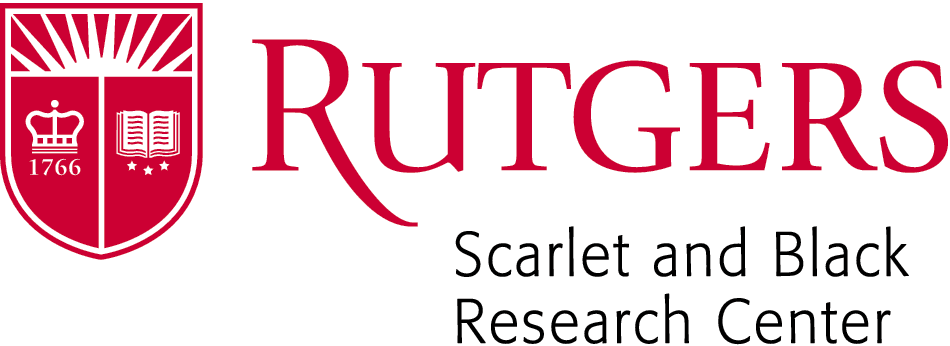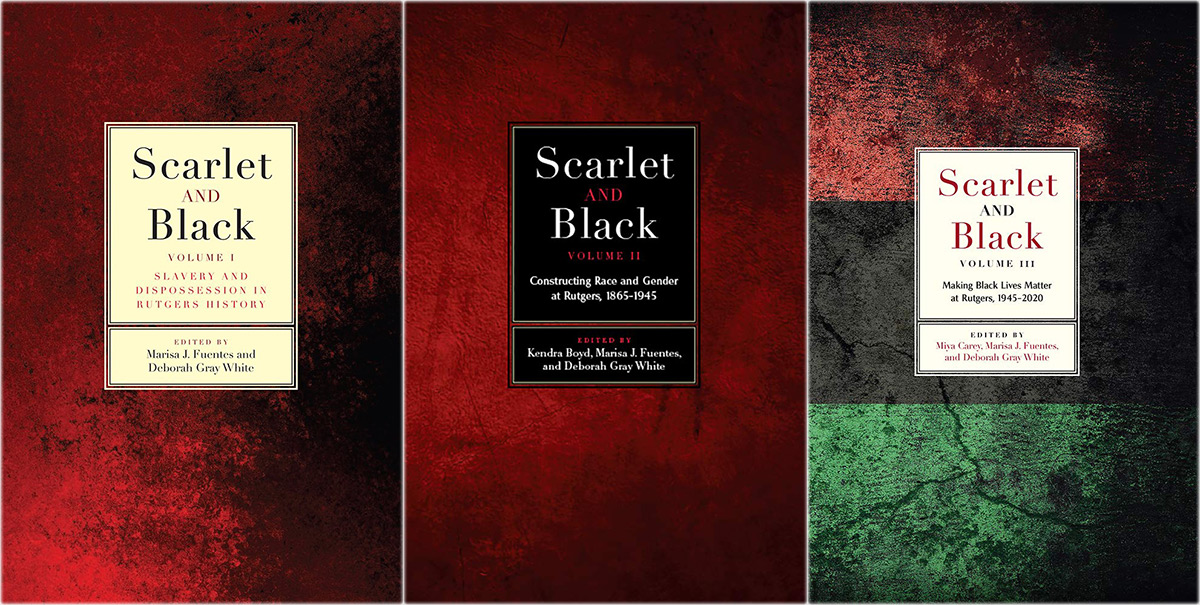The 3-volume Scarlet and Black series examines the history of race at Rutgers from slavery to Black Lives Matter.
- Volume 1: Slavery and Dispossession in Rutgers History
- Volume 2: Constructing Race and Gender at Rutgers, 1865-1945
- Volume 3: Making Black Lives Matter at Rutgers, 1945-2020
Scarlet and black are the colors Rutgers University uses to represent itself to the nation and world. They are the colors the athletes compete in, the graduates and administrators wear on celebratory occasions, and the colors that distinguish Rutgers from every other university in the United States. This body of work, however, uses these colors to signify something else: the blood that was spilled on the banks of the Raritan River by those dispossessed of their land and the bodies that labored unpaid and in bondage so that Rutgers could be built and sustained. The contributors to these volumes offer this history as a usable one—not to tear down or weaken this very renowned, robust, and growing institution—but to strengthen it and help direct its course for the future.
Scarlet and Black, Volume 1: Slavery and Dispossession in Rutgers History
edited by Marisa J. Fuentes and Deborah Gray White
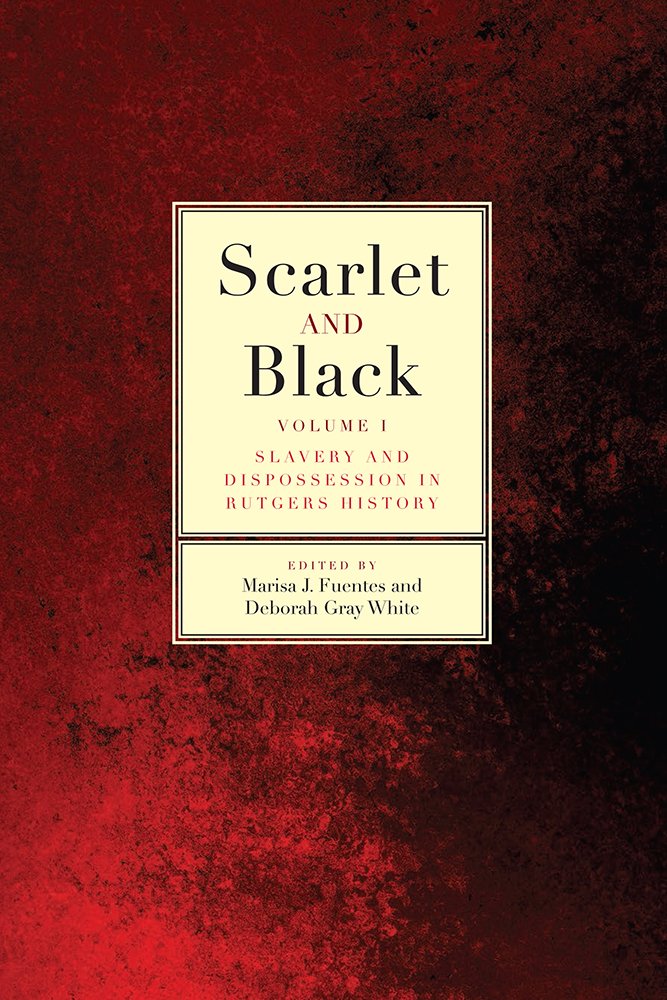
Published in 2016, the first volume documents the university’s early history, uncovering how the university benefited from the slave economy and how Rutgers came to own the land it inhabits. Rutgers’ connection to slavery was neither casual nor accidental—nor unusual. Like most early American colleges, Rutgers depended on slaves to build its campuses and serve its students and faculty; it depended on the sale of black people to fund its very existence.
Table of Contents for Volume 1
Foreword
Richard L. Edwards
Introduction: Scarlet and Black—A Reconciliation
Deborah Gray White
Chapter 1. “I Am Old and Weak…and You Are Young and Strong…”: The Intersecting Histories of Rutgers University and the Lenni Lenape
Camilla Townsend, with Ugonna Amaechi, Jacob Arnay, Shelby Berner, Lynn Biernacki, Vanessa Bodossian, Megan Brink, Joseph Cuzzolino, Melissa Deutsch, Emily Edelman, Esther Esquenazi, Brian Hagerty, Blaise Hode, Dana Jordan, Andrew Kim, Eric Knittel, Brianna Leider, Jessica MacDonald, Kathleen Margeotes, Anjelica Matcho, William Nisley, Elisheva Rosen, Ryan Von Sauers, Ethan Smith, Amanda Stein, and Chad Stewart
Chapter 2. Old Money: Rutgers University and the Political Economy of Slavery in New Jersey
Kendra Boyd, Miya Carey, and Christopher Blakely
Chapter 3. His Name Was Will: Remembering Enslaved Individuals in Rutgers History
Jesse Bayker, Christopher Blakley, and Kendra Boyd
Chapter 4. “I Hereby Bequeath…”: Excavating the Enslaved from the Wills of the Early Leaders of Queen’s College
Beatrice Adams and Miya Carey
Chapter 5. “And I Poor Slave Yet”: The Precarity of Black Life in New Brunswick, 1766–1835
Shaun Armstead, Brenann Sutter, Pamela Walker, and Caitlin Wiesner
Chapter 6. From the Classroom to the American Colonization Society: Making Race at Rutgers
Beatrice Adams, Tracey Johnson, Daniel Manuel, and Meagan Wierda
Chapter 7. Rutgers: A Land-Grant College in Native American History
Kaisha Esty
Epilogue: Scarlet in Black—On the Uses of History
Jomaira Salas Pujols
Scarlet and Black, Volume 2: Constructing Race and Gender at Rutgers, 1865-1945
edited by Kendra Boyd, Marisa J. Fuentes, and Deborah Gray White
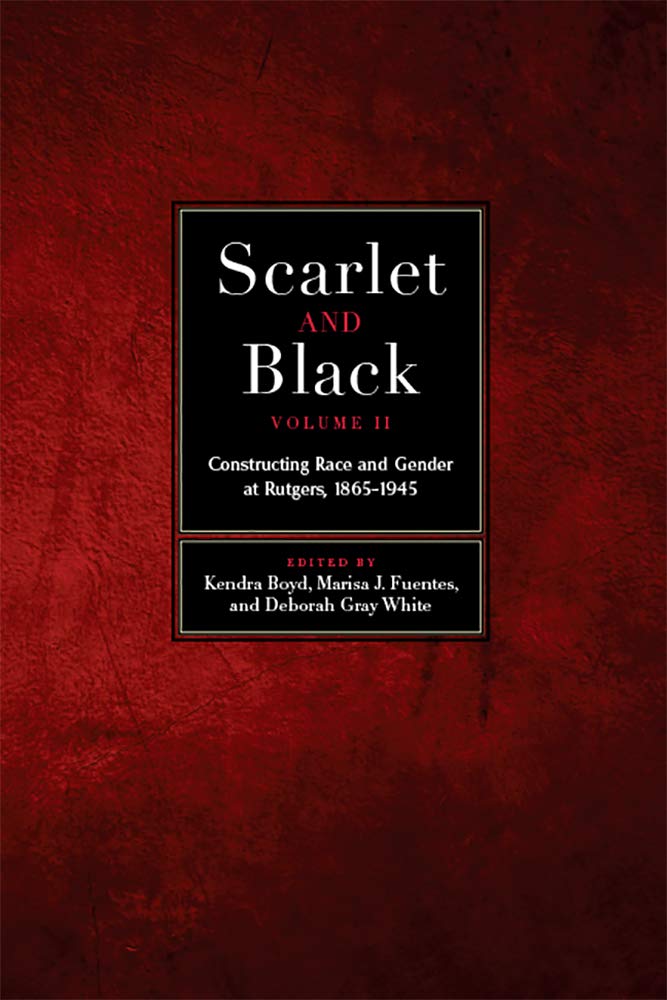
Scarlet and Black, Volume 2 was published in January 2020. This volume includes an introduction to the period from the end of the Civil War through WWII, an essay on race relations in New Brunswick and the rise of the local Ku Klux Klan, a study of the first black students at Rutgers and New Brunswick Theological Seminary, and profiles of the earliest black women to matriculate at Douglass College.
Table of Contents for Volume 2
Introduction
Deborah Gray White
Chapter 1. All the World’s A Classroom: The First Black Students at Rutgers College and New Brunswick Theological Seminary Encounter Racial Ideology, Missionary Impulses and the Intellectual Life of the University
Tracey Johnson, Eri Kitada, Meagan Wierda, and Joseph Williams
Chapter 2. In the Shadow of Old Queens: African American Life and Labors in New Brunswick from the End of Slavery to the Industrial Era
Caitlin Wiesner, Pamela Walker, Brenann Sutter, and Shari Cunningham
Chapter 3. The Rutgers Race Man: Early Black Students at Rutgers College
Beatrice J. Adams, Shaun Armstead, Shari Cunningham, Tracey Johnson
Chapter 4. Profiles in Courage: Breaking the Color Line at Douglass College
Miya Carey and Pamela Walker
Chapter 5. Race as Reality and Illusion: The Baxter Cousins, NJC and Rutgers University
Shaun Armstead and Jerrad P. Pacatte
Epilogue
Deborah Gray White
Scarlet and Black, Volume 3: Making Black Lives Matter at Rutgers, 1945-2020
edited by Miya Carey, Marisa J. Fuentes, and Deborah Gray White
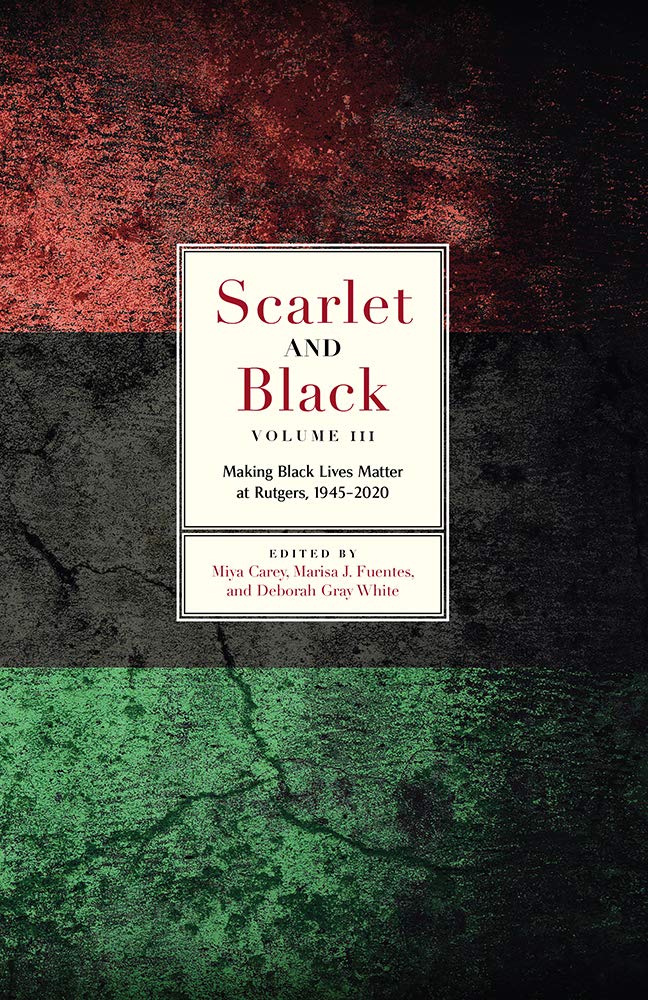
Published in May 2021, the third volume concludes this groundbreaking documentation and includes essays about Black and Puerto Rican students’ experiences at Livingston College; the Conklin Hall takeover in Newark and the Black Student Unity Movement protests in Camden; the divestment movement against South African apartheid; anti-racism struggles during the 1990s; and the Don Imus controversy and the 2007 Scarlet Knights women’s basketball team.
Table of Contents for Volume 3
Introduction
Deborah Gray White
PART I. Prelude to Change: Circa 1944–1977
Chapter 1. Twenty-Twenty Vision: New Jersey and Rutgers on the Eve of Change
Roberto Orozco, Carie Rael, Brooke Thomas, Deborah Gray White
Chapter 2. Rutgers and New Brunswick: A Consideration of Impact
Ian Gavigan and Pamela Walker
Chapter 3. “Tell It Like It Is”: The Rise of a Race-Conscious Professoriate at Rutgers in the 1960s
Joseph Williams
Chapter 4. Black and Puerto Rican Student Experiences and Their Movements at Douglass College, 1945–1974
Kaisha Esty, Whitney Fields, and Carie Rael
PART II. Student Protest and Forceful Change: A History of Black and Puerto Rican Student Organizing across Rutgers University Campuses, 1950–1985
Chapter 5. A Second Founding: The Black and Puerto Rican Student Revolution at Rutgers–Camden and Rutgers–Newark
Beatrice J. Adams, Jesse Bayker, Roberto C. Orozco, and Brooke A. Thomas
Chapter 6. Equality in Higher Education: An Analysis of Negative Responses to the Conklin Hall Takeover
Kenneth Morrissey
Chapter 7. The Black Unity League: A Necessary Movement That Could Never Survive
Edward White
Chapter 8. “We the People”: Student Activism at Rutgers and Livingston College, 1960–1985
Carie Rael and Brooke Thomas
PART III. Making Black Lives Matter beyond Rutgers, 1973–2007
Chapter 9. “It’s Happening in Our Own Backyard”: Rutgers and the New Brunswick Defense Committee for Assata Shakur
Joseph Kaplan
Chapter 10. Fight Racism, End Apartheid: The Divestment Movement at Rutgers University and the Limits of Interracial Organizing, 1977–1985
Tracey Johnson
Chapter 11. “Hell No, Our Genes Aren’t Slow!”: Racism and Antiracism at Rutgers during the 1995 Controversy
Meagan Wierda and Roberto Orozco
Chapter 12. “Pure Grace”: The Scarlet Knights Basketball Team, Don Imus, and a Moment of Dignity
Lynda Dexheimer
Epilogue: Scarlet and Black: The Price of the Ticket
Deborah Gray White
